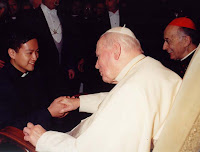 On January 30, 1996, we staged a play here in Don Bosco Canlubang. I was a young brother at that time and I wrote and directed that short musical entitled Bury Me Deep, based on the book by Peter Lappin, on the life of the young Argentinian native, Zeffirin (or Ceferino, Zephyrinus, Zephyrin, whatever language base the translation uses) Namuncurá. I opened the play with the end—the funeral scene where the company, led by Bro. Gerry Martin (now Fr. Gerry) who played the role of Bishop Giovanni Cagliero. It was a moving scene, accompanied as it was by Schubert’s Ave Maria. The end of the play continues the funeral scene with a Salesian saying: “Many years after his death, he indeed was buried deep—almost into oblivion. It is indeed sad to know all about it. Yet the name of Zeffirin will not languish forever buried…” And the reason given was that he was well way into the process of being raised to the altars.
On January 30, 1996, we staged a play here in Don Bosco Canlubang. I was a young brother at that time and I wrote and directed that short musical entitled Bury Me Deep, based on the book by Peter Lappin, on the life of the young Argentinian native, Zeffirin (or Ceferino, Zephyrinus, Zephyrin, whatever language base the translation uses) Namuncurá. I opened the play with the end—the funeral scene where the company, led by Bro. Gerry Martin (now Fr. Gerry) who played the role of Bishop Giovanni Cagliero. It was a moving scene, accompanied as it was by Schubert’s Ave Maria. The end of the play continues the funeral scene with a Salesian saying: “Many years after his death, he indeed was buried deep—almost into oblivion. It is indeed sad to know all about it. Yet the name of Zeffirin will not languish forever buried…” And the reason given was that he was well way into the process of being raised to the altars.
At that time I had a strong premonition that soon this young Bosconian would be beatified. How else would I explain that strong compulsion to put his life into a simple musical on the eve of the feast of Don Bosco? “Soon” turned out to be a little bit less than twelve years. It was not really a long time for me, for the 1996 production is, up to now, still vivid in my mind.
Last week, the Salesian world was in festive mood because last November 11, Zeffirin was beatified. But not only that. The whole Church is sharing in this joy for another young person has been raised to the altars. It is missionary work at its best! Even the Philippine Daily Inquirer ran the story (from Agence France Presse) about the beatification. In other words, it is big news.
Aye, it is big news, a big deal whenever we succeed in bringing out the best in our young people. I have told my faculty members that as teachers they are at the vanguard, at the forefront of this undertaking. I urged them—and you likewise—to help make more Zeffirins among the young whom we encounter everyday.


